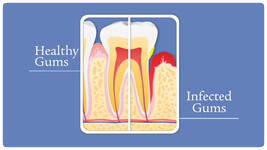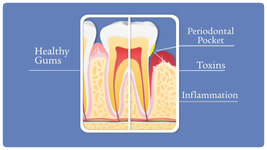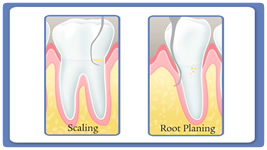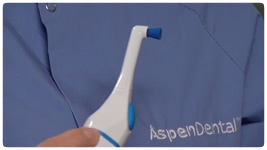
Periodontics |
ComfiDents® Dentures Links
- General Dentistry
- Crowns and Bridges
- ComfiDents® Dentures
- Periodontics
- Cosmetic Dentistry
- Emergency Dental Care
Smile Guide Video:
|
Aspen Dental ComfiDents® Dentures
Healthier gums can mean a healthier you.
Have you ever noticed that your gums bleed when you brush your teeth? Or that your teeth are very sensitive? Maybe your gums are sore, swollen or red. You may not realize it but those conditions, as well as bad breath, are signs of periodontal disease. You’ve probably heard it referred to as gum disease.
 Smile Guide Fact
Smile Guide Fact
More than 75 percent of
Americans have some
form of gum disease
and don’t know it.
Gum disease is an infection that can severely harm the gums and bone supporting your teeth. It can affect one tooth or many teeth. Like any infection that can develop elsewhere in your body, left untreated, gum disease can lead to serious and costly health issues.
Advanced stages of gum disease have been found to lead to tooth loss. Other complications can include:
- Heart attack
- Stroke,
- Diabetes
- Respiratory diseases
- Premature or underweight babies
That’s why Aspen Dental doctors take gum disease very seriously. The team wants to do everything possible to provide you with the care you need.
By examining your entire mouth, not just a specific problem, the doctor can determine whether you have conditions such as gum disease, and then get you started on the right treatment in the office and in your home. It’s all part of helping you find and keep your smile.
Explaining Periodontal Disease
- What is periodontal disease?
- What causes periodontal disease?
- How Aspen Dental can help.
- Why you should see us more often.
- What you can do to help.
Aspen Dental ComfiDents® Dentures
Periodontal Disease
What is periodontal disease?
Periodontal disease–or gum disease–is an infection that can severely harm the gums and bone supporting your teeth. It can affect one tooth or many teeth. Like any infection left untreated, gum disease has been linked to serious and costly health issues including:
- Tooth loss
- Heart attack
- Stroke
- Diabetes
- Respiratory diseases
- Premature or underweight babies
At Aspen Dental, we believe in comprehensive care. That’s why our doctor and hygienist will examine your entire mouth, not just a specific problem. We can then determine whether you have conditions such as gum disease, and get you started on the right treatment in our office and at your home.
| Back to the Top |
What causes periodontal disease?
Gum disease begins when the bacteria in plaque causes the gums to become inflamed. Gingivitis, the mildest form of gum disease, causes the gums to become red, swollen and bleed easily. There is usually little or no discomfort at this stage.
Infrequent and improper brushing and flossing often cause gingivitis. Additional gingivitis risk factors include:
- Genetics
- Smoking
- Diabetes
- Poor nutrition
Gingivitis is reversible with professional treatment and good oral care at home. That’s why it is important that brushing and flossing are part your everyday oral health routine.
If left untreated, gingivitis can turn into periodontitis. With time, plaque can spread and grow below the gum line. Toxins produced by the bacteria in plaque irritate the gums. Gums separate from the teeth and form pockets—the spaces between the teeth and the gums—and become infected.
As gum disease progresses, the pockets deepen and more gum tissue and bone are destroyed. Eventually teeth can become loose and may have to be removed. A simple examination by your doctor or hygienist to measure the pocket depths will determine the presence and seriousness of the condition.
| Back to the Top |
How Aspen Dental can help.
 Gum disease is treated with procedures called scaling and root planing. Specialized instruments are used below the gum line to remove plaque, tartar, and bacteria around the tooth and smooth the root surfaces. The goal of this non-surgical treatment is to reduce the pockets around the teeth.
Gum disease is treated with procedures called scaling and root planing. Specialized instruments are used below the gum line to remove plaque, tartar, and bacteria around the tooth and smooth the root surfaces. The goal of this non-surgical treatment is to reduce the pockets around the teeth.
To contain the bacteria, we also use a locally applied, time-released topical antibiotic that is specifically designed for the treatment of periodontal disease.
| Back to the Top |
Why you should see us more often.

Gum disease is treatable, but it’s not curable. They key is to keep it controlled. That’s why, instead of a typical 6-month check-up, the American Dental Association recommends a check-up and treatment every 3-4 months for patients with gum disease.
| Back to the Top |
What you can do to help.
 The Aspen Dental team will discuss a regular routine of dental care for you to do at home. This is critical in controlling periodontal disease. We recommend purchasing a special rotary toothbrush that removes plaque in between the teeth and below the gum line without damaging the tissue—something a standard toothbrush can’t do. Just a small investment in this specialized toothbrush along with a regular dental routine of brushing and flossing can prevent the higher cost of treatment down the road.
The Aspen Dental team will discuss a regular routine of dental care for you to do at home. This is critical in controlling periodontal disease. We recommend purchasing a special rotary toothbrush that removes plaque in between the teeth and below the gum line without damaging the tissue—something a standard toothbrush can’t do. Just a small investment in this specialized toothbrush along with a regular dental routine of brushing and flossing can prevent the higher cost of treatment down the road.
If you want to learn more about periodontal disease and how best to control it, ask anyone on your Aspen Dental team, or visit the American Dental Association website at ada.org. We look forward to helping you find your smile.
| Back to the Top |